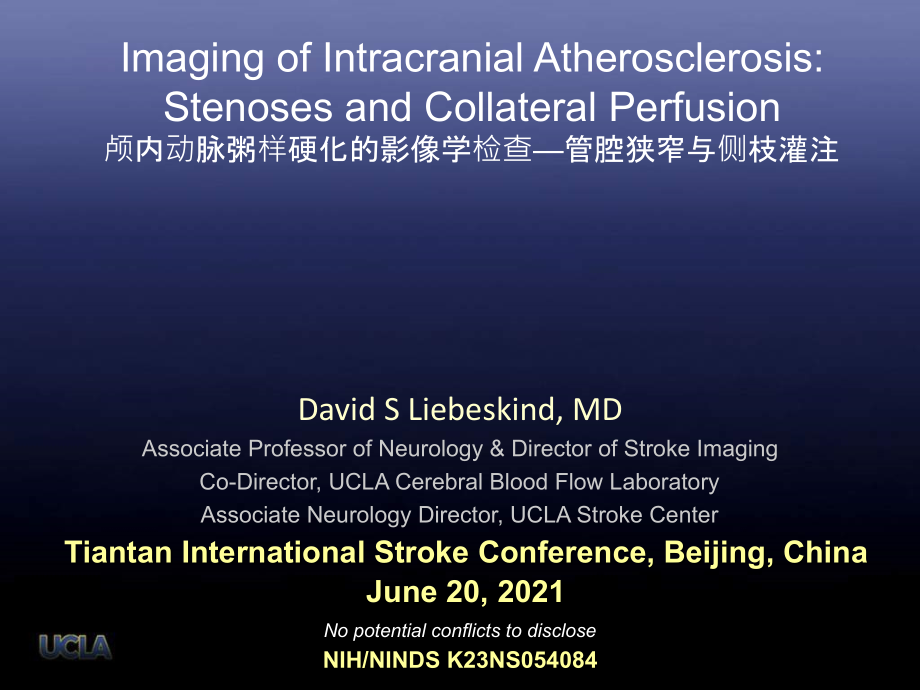 颅内动脉粥样硬化的影像学检查—管腔狭窄与侧枝灌注(英文)
颅内动脉粥样硬化的影像学检查—管腔狭窄与侧枝灌注(英文)



《颅内动脉粥样硬化的影像学检查—管腔狭窄与侧枝灌注(英文)》由会员分享,可在线阅读,更多相关《颅内动脉粥样硬化的影像学检查—管腔狭窄与侧枝灌注(英文)(56页珍藏版)》请在装配图网上搜索。
1、Imaging of Intracranial Atherosclerosis:Stenoses and Collateral Perfusion颅内动脉粥样硬化的影像学检查管腔狭窄与侧枝灌注David S Liebeskind,MDAssociate Professor of Neurology&Director of Stroke ImagingCo-Director,UCLA Cerebral Blood Flow Laboratory Associate Neurology Director,UCLA Stroke CenterNo potential conflicts to dis
2、closeNIH/NINDS K23NS054084NIH/NINDS K23NS054084June 20,2021June 20,2021Tiantan International Stroke Conference,Beijing,ChinaTiantan International Stroke Conference,Beijing,China DSLObjectives 目的Overview of current imaging in intracranial atherosclerosisConsider arterial lesions beyond degree of lumi
3、nal stenosisUnderscore the paramount role of collateral perfusionExplore how imaging of intracranial atherosclerosis may provide insight on many other aspects of ischemic stroke DSLIschemia 缺血Ischemia as principal pathophysiologic event,collaterals may avert any detrimental effect of thrombosis or p
4、laqueVast majority of efforts focus on restoration of antegrade flow,anti-thrombotics or arterial manipulation DSLHemorrhagic transformation 出血性转化Severe ischemia and neurovascular compromiseReperfusion rate ischemic pre-and post-conditioning driven via collaterals DSL DSLTime is not brain!Across pop
5、ulation of stroke cases studied from onset to chronic phase,not in a given patient during early phasesTime of symptom onset time of vascular occlusionCollaterals prone to failure over time DSL DSLMoyamoyaIdeal model of collaterals in chronic cerebral ischemiaStriking consistency in stenotic arterial
6、 featuresUniversal dependence on leptomeningeal collateralsStrokes are typically limited in extent,allowing for recoveryTIA without stroke should be goalRecurrent ischemia and temporal features easily studied DSLImaging Tools to understand physiology,mechanismsNot TCD vs.CTA vs.MRA vs.DSA etc.Distin
7、ct features emphasized by each modalityAnatomyFlow DSLTrialsSONIA in parallel with WASIDSAMMPRISOpportunity to discern mechanismsNot just%stenosisFlow at lesion QMRATCD with embolus detectionCollaterals on DSA DSLN of 1-intracranial atherosclerosisDiagnosis,rational selection of therapy Peri-procedu
8、ral/serial imagingOpportunity to revise treatment strategy DSLLesion/stenosisLength and architecture of plaque DSLTCD beyond velocitiesMFV,PI,AUCCurrent TCD velocity criteria for diagnosis of intracranial stenosis are insensitive to age-and gender-related changes in cerebral blood flowTCD diagnosis
9、based on published criteria may overestimate disease prevalenceLab-specific norms may need to be established to account for demographic features of population DSLCTA DSLCTA SpecificsLuminal contents identified by filtering of image data based on Hounsfield unitsContrast opacification errors due to a
10、dministration,dosing,body habitus,injection rate,bolus trackingWindow width and center levels are critical Measurement of stenosesErroneous fusion of different structuresAutomated bone segmentationCalcifications DSLCTA SpecificsPredominantly anatomical angiographic imagesInsensitivity to flow physio
11、logyLack of temporal resolution DSLFuture of CTAImproved image quality with increasing multidetector capabilityPossible temporal resolutionContrast modificationsAlternative agentsRefined dosing schemes DSLCTA of Stented Artery DSLMRAFlow-sensitive nature of MRIGradient echo imaging rapid scan acquis
12、ition with particular sensitivity to flow-related effectsMRA techniques include time-of-flight(TOF)and phase contrast(PC)imaging DSLTime-of-Flight(TOF)MRAInflow of fully magnetized spins into a slice saturated by a radiofrequency pulse2D TOF MRA thicker slices,lower signal-to-noise ratios3D TOF MRA
13、thin slices,higher signal-to-noise ratiosSignal intensity dependent on slice thickness,flip angle,TE Magnetization transfer contrast for background suppression Multiple overlapping thin slab angiography(MOTSA)DSLTime-of-Flight(TOF)MRA DSLGadolinium-Enhanced MRAImproves vascular signal intensityReduc
14、es signal dropout due to slow flowDynamic or time-resolved MRATemporal resolution offset by limited spatial resolution DSLGadolinium-Enhanced MRA DSLPhase Contrast(PC)MRA相位比照MRAPC MRA employs gradients that induce phase shifts in flowing blood with subsequent background subtractionGradient modificat
15、ions allow for determination of flow direction and flow rateMapping of flow directionMeasurement of flow ratesDifferentiating slow flow from frank thrombosis DSLMRA SpecificsInferior spatial resolutionLimited depiction of arterial structures beyond the proximal cerebral vesselsFlow-related artifacts
16、 due to slow or turbulent flowSusceptibility artifact induced by metal clips or objectsPatient motion may limit diagnostic utility DSLMRA Artifacts DSLWillisian collateralization DSLDSA DSLMethodology/critical appraisal?Frequently encounter case series biased by other selection biasesSONIANot how we
17、 generally use techniquesRule-out disease DSLIntracranial vascular calcification DSLPlaque stabilityUSPIOVessel wall imaging T1-weighted post-contrast images DSLGRE and phase imagingGRE =background magnitude +phase =+DSLFVHSlow collateral flow distal to severe lesionsRelatively rare DSLAsymptomatic
18、stenosesWASID,18.9%(n=14/74)on 4-vessel cerebral angiography and 27.3%(n=65/238)on MRADuring a mean follow-up period of 1.8 years,no ischemic strokes were attributable to an AIS on angiography and 5 ischemic strokes(5.9%,95%CI:2.1%to 12.3%)occurred in the AIS territory on MRA(risk at 1 year=3.5%,95%
19、CI:0.8%to 9.0%)Adequate collateral flow may offset ischemia and help embolic washout DSLCollaterals in WASIDCollateral circulation assessed on 287/569(50%)angiograms performed at study entry demonstrating proximal arterial stenosis ranging from 50-99%ASITN/SIR collateral grade broadly distributed0(a
20、bsent or no collaterals)in 69%1(slow,minimal)in 10%2(more rapid,yet incomplete perfusion of territory)in 7%3(complete but delayed perfusion)in 11%4(rapid and complete collateral perfusion)in 4%DSLCollaterals and WASID stenosesThe extent of collateral flow for all proximal arterial lesions(ICA,MCA,BA
21、,VA)correlated with the percentage of stenosis(p0.001),with more severe stenoses exhibiting greater compensatory collateral flowThe full range of collateral grades,however,was evident at all percentages of stenoses DSLCollaterals determine stroke riskAcross all percentages of stenosis,extent of coll
22、ateral circulation an independent predictor for subsequent stroke in territory of symptomatic artery(p0.0001)DSLDivergent risk patternsContradictory role of collaterals in cases with severe (70%)versus mild or moderate stenoses(50-69%)Protective influence of collaterals in severe stenosisOminous mar
23、ker of future stroke in milder stenosesCox proportional hazards model confirmed this interaction(p=0.001)DSLWhy have collaterals at 54%?DSLSevere stenosesGood collateralsPoor collateralsNo collaterals DSLCollaterals as ominous markerConversely,at milder degrees of stenoses(50-69%)the presence of mor
24、e extensive collaterals was associated with a greater likelihood of subsequent stroke(p0.0001)DSLMild or moderate stenosesGood collateralsNo collateralsPoor collaterals DSLCollateral perfusion on DSA DSLNoninvasive perfusion imagingNot CT versus MRI,but reflection of physiology!Must consider identic
25、al perfusion parametersMultiparametric approaches to understand hemodynamics and evolving ischemia DSLCBVMTTCBFCT perfusion DSLCT perfusion DSLMR perfusion or PWI DSLMeaningless delays?DSLFocal delay without symptoms DSL ChangeCBF OEF CMRO2 CBVMTT(CBV/CBF)VR(hypercapnia)VR(hypocapnia)Hemodynamics an
26、d CBV!DSL DSL DSLCBVIschemic stroke due to IA results in dramatically less severe neurological deficits and diminished lesion volumesTime-domain perfusion parameters(e.g.Tmax)may not accurately reflect ischemic severity unless stroke etiology is considered DSLLow perfusion hyperemiaHyperemia,or incr
27、eases in relative CBV values,were evident in regions of“oligemia in all cases(p0.001).CPP was decreased,exhibiting a gradient extending deep from the cortical surface in all cases(p0.001).DSLLessonsIntracranial atherosclerosis newest area,yet critical lessons about ischemic stroke in generalRisk/benefit estimates ultimate goal,especially with high-risk interventions such as stentingImaging for detection and triage based on mechanism,expected prognosis at serial timepoints!
- 温馨提示:
1: 本站所有资源如无特殊说明,都需要本地电脑安装OFFICE2007和PDF阅读器。图纸软件为CAD,CAXA,PROE,UG,SolidWorks等.压缩文件请下载最新的WinRAR软件解压。
2: 本站的文档不包含任何第三方提供的附件图纸等,如果需要附件,请联系上传者。文件的所有权益归上传用户所有。
3.本站RAR压缩包中若带图纸,网页内容里面会有图纸预览,若没有图纸预览就没有图纸。
4. 未经权益所有人同意不得将文件中的内容挪作商业或盈利用途。
5. 装配图网仅提供信息存储空间,仅对用户上传内容的表现方式做保护处理,对用户上传分享的文档内容本身不做任何修改或编辑,并不能对任何下载内容负责。
6. 下载文件中如有侵权或不适当内容,请与我们联系,我们立即纠正。
7. 本站不保证下载资源的准确性、安全性和完整性, 同时也不承担用户因使用这些下载资源对自己和他人造成任何形式的伤害或损失。
